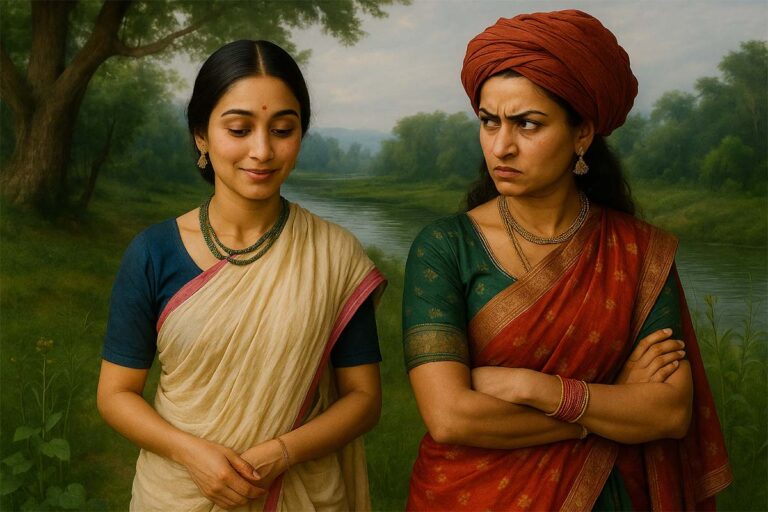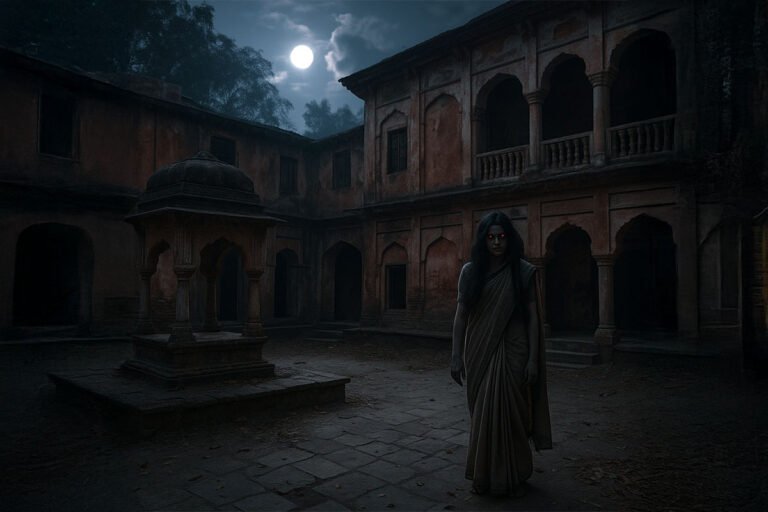— As contributed by Dr. Sharmila Rao P.N.
Long ago, Madhvacharya, the founder of the Dvaita school of Vedanta, lived in Udupi, a coastal town in Karnataka. Known for his wisdom and deep devotion to Lord Vishnu, he followed a strict spiritual routine, which included going to the seashore every morning to bathe and offer prayers.
One day, while meditating near the sea, Madhvacharya noticed a ship caught in a violent storm, struggling to stay afloat amid the towering waves and strong winds. Recognizing the peril, he took off his uttariya (a traditional upper cloth) and waved it in the direction of the ship. Miraculously, the storm calmed, and the ship safely reached the shore.
The grateful ship captain, a merchant, came ashore and thanked the saint, offering him precious riches in gratitude. But Madhvacharya declined all material offerings, saying he had no use for gold or jewels. Instead, he said, “At the bottom of your ship, there are two heavy lumps of ‘gopi-chandana’ (clay). Please give those to me.”
The captain, though puzzled, agreed. Upon retrieving the clay lumps and giving them to Madhvacharya, something extraordinary happened. As he carried them back, the first block broke open, revealing a beautifully carved idol of Lord Balarama, the elder brother of Krishna. This idol was later installed at Vadabhandeshwara, near Malpe.
He continued on to Udupi with the second block of gopi-chandana. When this piece was opened, it revealed an idol of Lord Krishna, in his child form, known as Koupiṇa Dhari Krishna Murari — a young Krishna holding a kadagolu (butter churn). It is believed that this was the very idol once worshipped by Rukmini, Lord Krishna’s consort.
Madhvacharya installed this Krishna idol at the Udupi Sri Krishna Matha, which later became a major pilgrimage center and spiritual hub. The unique feature of this temple is that the idol of Krishna is worshipped through a small window with nine holes, traditionally known as the Navagraha Kitiki and reverently referred to as Kanakanakindi in honor of the saint Kanakadasa. It is also said that Krishna himself turned to face west to grant darshan to his devotee, Kanakadasa, a lower-caste saint who was denied entry into the temple from the front.
The temple is also called the Roupya Peetha (Silver Pedestal) because of the pedestal on which the Krishna idol was installed.
Note:
This beautiful folktale was shared with us by Dr. Sharmila Rao P.N. as part of our ongoing effort to preserve and share the rich oral traditions of India. We thank her for this wonderful contribution to Folklore Chronicles.









2 Responses
Thanks for sharing. However the input I had given is ‘gopi-chandana’ which is clay and not sandalwood. Also the window through which Krishna is viewed is Kanakanakindi and navagraha kindi no matter however many re-naming it Kanakanadini in honour of the saint. On my blog those tales are very much there. Will share it here too.
Dear Dr. Sharmila Rao,
Namaskar and thank you so much for your kind reply and for sharing this wonderful folktale with us. We are truly grateful for your contribution and the insightful clarifications you have provided regarding gopi-chandana and the naming of the window through which Lord Krishna is viewed.
For our initial draft, we had referred to the following sources for reference and context:
However, as folktales are traditionally passed down orally and often evolve through generations, we deeply value authentic voices like yours. Based on your input, we have now updated the text to reflect ‘gopi-chandana’ (clay) instead of sandalwood, and we have also added the correct names Kanakanakindi to preserve accuracy and tradition.
We are honored to share your version on Folklore Chronicles and look forward to receiving more stories from your blog that you’d be willing to share with us. It would be our pleasure to publish them with proper attribution to you.
Warm regards,
Leo Patnaik